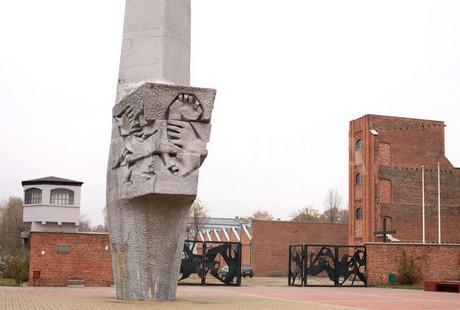Radogoszcz Prison
While not nearly as famous as some of the Nazi killing fields found in Poland the conditions in Radogoszcz prison were unflinchingly brutal, and what remains today is a stark insight into the evil mechanics of the Third Reich. As if to bring the horror into even sharper focus is Radogoszcz’s location, smack in the centre of residential Lodz, and a visit to this often forgotten camp proves every bit as sobering as it is essential.
Getting to Radogoszcz is a cinch, with taxis charging around 25zl from the centre. To return back to town you’ll usually find a couple of cabs lurking around the gates of the nearby cemetery. Trams number 3 and 4 run up Zgierska stopping directly outside the prison, and run past Manufaktura and parallel to Piotrkowska on the way back.
The buildings which housed Radogoszcz prison were originally constructed in the 1930s, built at the behest of the industrialist Samuel Abbe. On the outbreak of WWII the red brick factory complex was requisitioned by the Polish army, before passing into the hands of the victorious Germans on September 8th. For the first month it functioned as a Wehrmacht barracks, before being turned into a transit camp for Polish political prisoners and other individuals deemed a threat to Nazi ideology. As time marched on the camp grew to operate as a prison and labour camp, processing an estimated 40,000 inmates throughout the duration of the war –a quarter of which are thought to have been killed. From the outset conditions were harsh; Radogoszcz was a factory first and foremost, and this was reflected in the facilities. Beds, kitchens and bathrooms took months to be added, and while it’s hard to put an exact figure on the number who died disease, maltreatment and executions were standard. However, the grimmest chapter of Radogoszcz’s history was to come on the night of January 18, 1945. With the Red Army approaching, and liberation just hours away, Nazi wardens embarked on the summary execution of all prisoners. The inmates rose in spontaneous rebellion, forcing the guards to flee the premises; but not before locking the prisoners into the factory and setting fire to the grounds – an estimated 1,500 people died in the ensuing inferno, with only thirty people surviving to see peace.
The hasty Nazi retreat left Radogoszcz a smouldering shell of what once it was. It’s importance as a site of struggle and martyrdom was not lost on the locals, and work began immediately on conserving the site and turning it into a memorial for all who died and suffered. An exhibition was opened on the third anniversary of Lódź’s liberation, and on September 9, 1961 a thirty metre spire was unveiled on the site of the former camp. Four watchtowers (one of them an original), were reconstructed, and the skeletal ruins brushed up and restored. The courtyard, slightly smaller than the original, is today home to numerous artsy memorials, none of them notable for being anything more than a little hideous. A number of plaques commemorate those died within these perimeters, as well as Lodz citizens deported to Mauthausen and Dachau, while along one of the exterior walls (running by ul. Zgierska) lies the mass grave of 37 unidentified victims. A token collection of Soviet artillery is also on view, as is a boiler recovered from the smoking ruins.
The exhibition hall lies just beyond the hollow shell which once housed the factory, and though the displays are accompanied by English text it’s well worth investing 20zl on the excellent ‘A Book of Lodz Martyrdom’. The prescribed tour takes visitors through a chronological history through wartime Poland, beginning with the 1939 invasion and the subsequent battle for Lódź. Posters calling men to arms, gas masks and grenades sit behind glass cases, paying tribute to those who gallantly resisted the Nazi war machine, before giving way to numerous exhibits detailing life under fascist rule. Innocuous everyday items like beer bottles, cigarette boxes and tea cups sit alongside more sinister displays; Germanized street signs, execution lists and photos of Lodz decked out with fluttering swastikas. It looks chilling enough, but it’s not half as thought provoking as what lies in store. Beyond the initial displays are the mugshots of dozens of children seized from their parents and sent away to be ‘Germanized’ in the camp on ul. Sporna 73. Next up, a section devoted to the Jewish Ghetto, with items of note including ghetto currency and the yellow stars which all habitants were compelled to wear. Further on an urn contains soil recovered from the site of the Katyn massacre, and there’s also a display of letters from concentration camp prisoners, striped uniform and even a bar soap allegedly made from human fat. Your tour concludes with a couple of rooms dedicated to Radogoszcz itself. Standing centre stage are copies of a flogging block and a prisoners bunk, while clinging to the walls are the photos of hundreds of inmates, as well as team photos of cheery looking guards. None of this prepares you for the final room, however. It’s here that the events of January 18th, 1945 are remembered. The photographs of charred, burned bodies leave nothing to the imagination, while making the display all the more poignant are a collection of 88 singed family photographs recovered from the dead.



